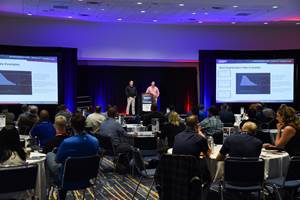Keeping Up with ISO: Moving to ISO 9001:2015 Requires a Top-Down Approach
Implementing ISO guiding principles to govern every activity within a moldmaking or molding facility is essential to properly managing the supply chain. This new column will share knowledge, highlight opportunities and spotlight rewards of the ISO 9001: 2015 revision.
A quality management system (QMS) is the framework of policies, processes and procedures used to ensure that a company can fulfill all tasks required to achieve its objectives. The International Organization for Standardization (ISO) 9001 quality management system places greater emphasis on building this system to suit each company’s particular needs and strives to give companies a high-level understanding of the important issues that can affect these systems. A revision to this standard was released in September 2015, and all companies currently certified to ISO 9001:2008 will be required to update or transition to the new requirements within three years (by September 2018). This new column is intended to help guide moldmakers and molders to ISO compliance, linking their day-to-day work metrics to financial metrics.
The purpose of ISO 9001 is to help organizations provide products and services that meet all relevant customer needs and expectations, and comply with all relevant regulatory and statutory requirements. Any organization can achieve these objectives if it establishes a QMS and continually works to improve its suitability, adequacy and effectiveness.
The requirements of ISO 9001:2015 include both manufacturing and administration processes, such as document control, records management, corrective action, customer surveys, supplier report cards, apprenticeship training and internal audits. These provide objective evidence that a company is operating with the proper controls, policies, procedures and practices to help ensure customer requirements are met. Such evidence is obtained in booking customer orders, purchasing raw materials, fulfilling orders, and handling customer returns and complaints.
These same operational controls are also the foundation for much of a company’s financial data, including, for example, inventory, revenue, and customer credits and/or allowances. Even ISO 9001’s requirements related to job duties, responsibilities and communications throughout the company contribute to the control environment that’s so important for the credibility of financial information.
Five key aspects of internal control are the control environment, risk assessment, control activities, information and communications, and monitoring. These align with various operational controls in an ISO 9001 system, such as compliance with the Sarbanes-Oxley (SOx) Act, financial transactions and accounts, internal audits, financial controls, and “walk-through” methodology for integrated audits.
All of these activities must start at the top. Therefore the biggest change in the standard requires that the CEO/owner take ownership of the compliance process, replacing the quality manager, which was a position typically held by small moldmakers and molders with limited resources. Top management is now required to demonstrate leadership and commitment, and ensure the integration of QMS requirements into the company’s business processes, maintaining quality objectives to support the achievement of the organization’s business goals.
The CEO/owner is responsible for the strategic leadership of the organization to ensure its future relevance, credibility and viability. Now, establishing ISO organizational objectives and priorities, reviewing and evaluating the progress, and working for attainment of these ISO objectives and performance goals falls to this senior position as well.
The CEO also maintains staff focus on the company’s mission and vision, and balances organizational priorities through an inclusive strategic planning and management system. He or she seeks out opportunities to improve organizational operations and shifts organizational philosophy to integrate departments and programs to function as a strong, cohesive operation. Another duty is developing policies and strategies for financial management, including revenues, expenses and investments, while ensuring rigorous accountability and long-term stability through conservative fiscal management of resources. The CEO is also responsible for guiding and integrating department heads’ efforts to realign all business processes, as well as for encouraging and facilitating the application of technology to enable the re-engineering of programs and processes to make optimal use of resources.
Other objectives for the ISO revision include greater emphasis on the process approach and measurable results to demonstrate continuous improvement; greater flexibility with how documentation and leadership activities are addressed to adapt to specific needs of individual companies; risk-based thinking to include planning, identification and addressing risks that may impact products, services and customers; better alignment with related standards such as ISO/TS 16949, ISO 13485, FDA GMPs, ISO 14001, OHSAS 18001 and financial statements to make it easier to maintain more than one certification; required industry-specific knowledge from consultants and auditors; and self-compliance ISO certification. These should make the ISO 9001 certification more effective in helping companies of any size in any industry manage risk, improve quality and better serve their customers.
ISO 9001:2015 can also bring growth and financial benefits to a company by helping to increase productivity and efficiency; lower costs; improve customer experiences; increase repeat business, sales and income; enhance the company’s reputation; and attract new markets and customers.
Next month’s column will examine the new and revised Clauses 1-10. As you digest each column, your organization will be on its way to reducing costs, increasing efficiency, gaining access to new markets and establishing a competitive advantage for itself.
Related Content
Top 10 Topics to Cover During an ISO 9001 Manufacturing Audit
Take a look at this practical hands-on approach to conducting a quality audit.
Read MoreTreatment and Disposal of Used Metalworking Fluids
With greater emphasis on fluid longevity and fluid recycling, it is important to remember that water-based metalworking fluids are “consumable” and have a finite life.
Read MoreCertified Quality Management for Plastics Professionals – Materials to Tooling to Recycling
Why is certification of a shop’s quality management system to ISO 9001, AS9100, IATF 16949 or ISO 13485 so special? What does the certification signify? And what supports the paper behind the framed certificate?
Read MoreMoldMaking Conference Session Spotlight: Data
Want to learn about digital workflows in mold design or ERP or global mold monitoring and asset management or the impact of tooling digitalization?
Read MoreRead Next
Reasons to Use Fiber Lasers for Mold Cleaning
Fiber lasers offer a simplicity, speed, control and portability, minimizing mold cleaning risks.
Read MoreHow to Use Continuing Education to Remain Competitive in Moldmaking
Continued training helps moldmakers make tooling decisions and properly use the latest cutting tool to efficiently machine high-quality molds.
Read MoreHow to Use Strategic Planning Tools, Data to Manage the Human Side of Business
Q&A with Marion Wells, MMT EAB member and founder of Human Asset Management.
Read More




















